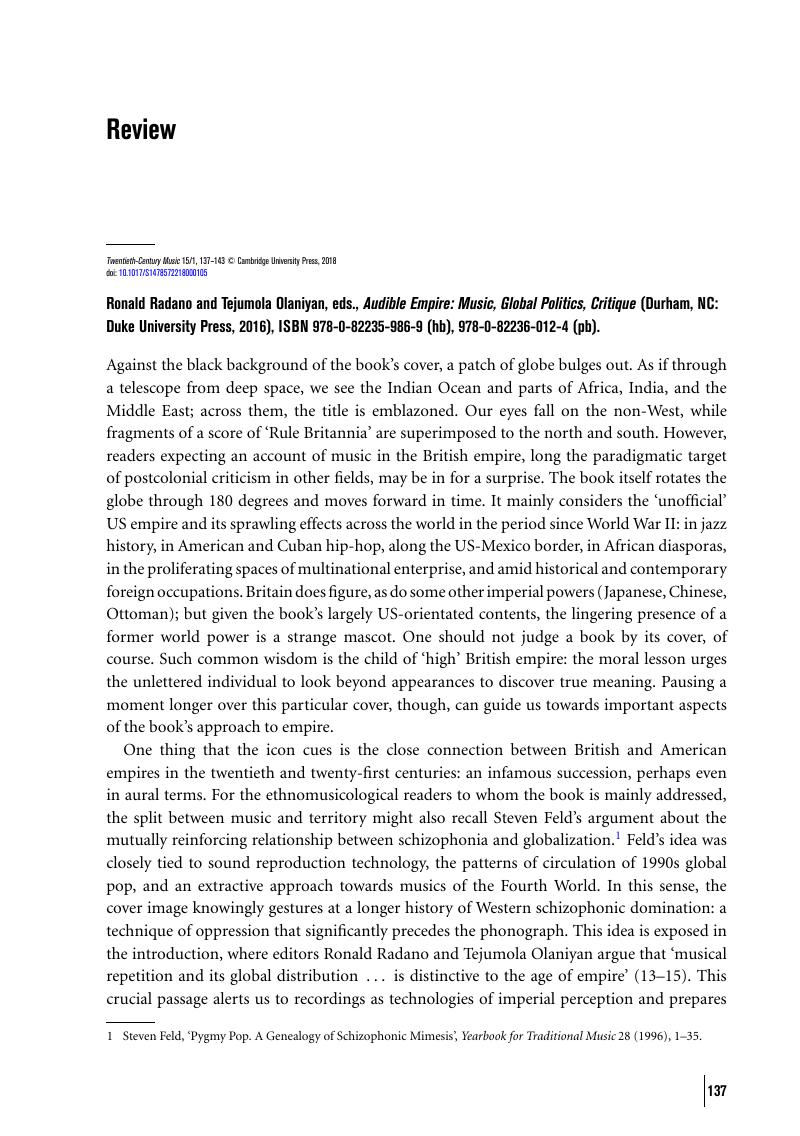No CrossRef data available.
Article contents
Ronald Radano and Tejumola Olaniyan, eds., Audible Empire: Music, Global Politics, Critique (Durham, NC: Duke University Press, 2016), ISBN 978-0-82235-986-9 (hb), 978-0-82236-012-4 (pb).
Published online by Cambridge University Press: 26 April 2018
Abstract

- Type
- Reviews
- Information
- Twentieth-Century Music , Volume 15 , Special Issue 1: Special Issue: Spectral Thinking , February 2018 , pp. 137 - 143
- Copyright
- Copyright © Cambridge University Press, 2018
References
1 Feld, Steven, ‘Pygmy Pop. A Genealogy of Schizophonic Mimesis’, Yearbook for Traditional Music 28 (1996), 1–35CrossRefGoogle Scholar.
2 Jonathan Sterne famously argues that sound reproduction technology depends on the development of a ‘social belief’ in the efficacy of sonic machines in the nineteenth century, but he does not discuss the geography of its spread; see his The Audible Past: Cultural Origins of Sound Reproduction (Durham: Duke University Press, 2003).
3 In highlighting the anti-colonial possibilities of recorded sound, Denning offers a refreshing take on a familiar topic; yet the exclusively positive valence of music will provoke familiar musicological questions, along with more specific concerns about his lack of explanation as to how the ear was ‘colonized’ in the first place. See also a review of his book-length version of this argument by Shayna Silverstein in this journal, 14/1 (2017), 164–8.
4 Stoler, Ann Laura, McGranahan, Carole, and Perdue, Peter C., eds., Imperial Formations (Santa Fe: School for Advanced Research Press, 2007)Google Scholar. Focus on the inter-imperial is rare in music studies, but is beginning to emerge: see, in particular, Liao's, Yvonne chapter ‘Empires in Rivalry: Opera Concerts and Foreign Territoriality in Shanghai, 1930–45’, in Operatic Geographies, ed. Aspden, Suzanne (Chicago: University of Chicago Press, in press)Google Scholar.
5 See, for example, Balakrishnan, Gopal, ‘Hardt and Negri's Empire’, New Left Review 5 (2000), 142–8Google Scholar.
6 A key text is anthropologist Howe's, David anthology, Empire of the Senses: The Sensual Culture Reader (London: Berg, 2004)Google Scholar. Since then, the anthropology and history of the senses has become further institutionalized through Constance Classen's six-volume Cultural History of the Senses (London: Bloomsbury, 2014); vol. 5 is devoted to ‘The Age of Empire’.
7 Yet it is easy to understand the editors’ trepidation when it comes to sound studies: a field that routinely eschews the ‘cultural and local’ (4) in its discussions of large-scale transformations in perception supposedly wrought by technology. Along similar lines, Amanda Weidman's chapter in this volume contains a brief critique of sound studies from an anthropological perspective (316–17).
8 Gautier's, Ana María Ochoa, Aurality: Listening and Knowledge in Nineteenth-Century Columbia (Durham: Duke University Press, 2014)Google Scholar; Davies, James Q., ‘Instruments of Empire’, in Sound Knowledge: Music and Science in London, 1789-1851, ed. Davies, and Lockhart, Ellen (Chicago: University of Chicago Press, 2016), 145–174Google Scholar.




